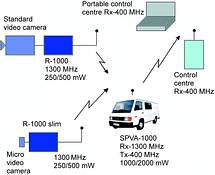

The widespread acceptance of video surveillance has been hampered in many cases by extensive wiring requirements and limited operational range. This is typically influenced by line of sight restrictions and multipath problems.
An innovative system that overcomes most of these problems comprises a sophisticated, multipath resistant, digital channel used to convey video images from remote video cameras to a central re-translator unit. This in turn transmits the signal at a suitable higher power level to the distant control centre. The system provides for video, stereo audio as well as a data link.
Standard video cameras (miniature or otherwise) are coupled to R-1000 transmitter units (see graphic) typically operating at 2400 MHz with an application dependent output power ranging from 10 to 1000 mW. The video and audio feeds are compressed using MPEG2 and NICAM encoding respectively and then multiplexed with the data stream. The combined data package is subsequently modulated using coded orthogonal frequency division multiplexing (COFDM) technology. The data stream is then up-converted to the transmission frequency.
Up to 24 such transmitter units communicate to a central re-translator unit (SPVA-1000). An R-1000 receiver unit receives the 2400 MHz signals from the remote units, demodulates them and re-modulates them onto a 400 MHz carrier at application-dependent output power up to 10 W. The direct re-modulation of the signal onto the 400 MHz carrier removes the need for MPEG-2 decoding at this point, thus optimising the data integrity.
The transmitted signal is received at the control centre, typically by a conventional R-1000, 400 MHz receiver and fed into a digital storage data bank (eg, a Panasonic TRX7000). A mobile monitor option could be accommodated at the re-translator site. This would consist of an R-1000 2400 MHz receiver and portable recorder (eg, a Sony DVR1000).
This COFDM based system provides an attractive opportunity to implement high reliability, non-line of sight, video transmission. COFDM's rugged modulation technique has led to its recent selection for two new broadcasting standards, DAB and DVB-T. DAB was specifically designed to cope with reception in moving vehicles involving time-varying multipath reception.
Typical achievable distances are 900 m and 350 m for 'line of sight' and 'non-line of sight' resp for 250 mW, and 1300 m and 600 m resp for 500 mW. An external power amplifier and directional antenna, could be added, providing further distance ranges.
| Tel: | +27 11 726 6758 |
| Email: | [email protected] |
| www: | www.eispty.co.za |
| Articles: | More information and articles about Electronic Industry Supplies |

© Technews Publishing (Pty) Ltd | All Rights Reserved